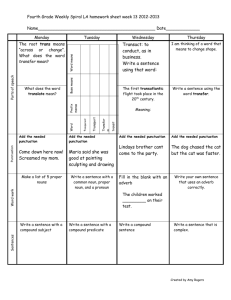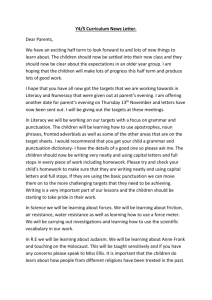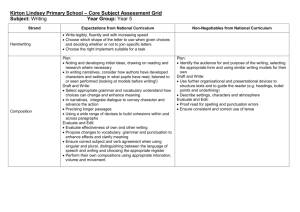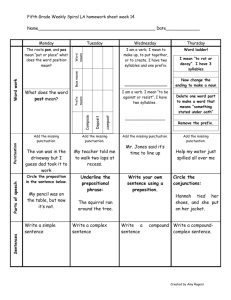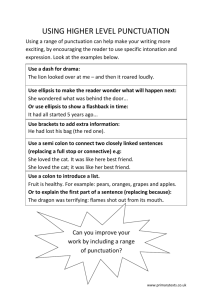Name
advertisement
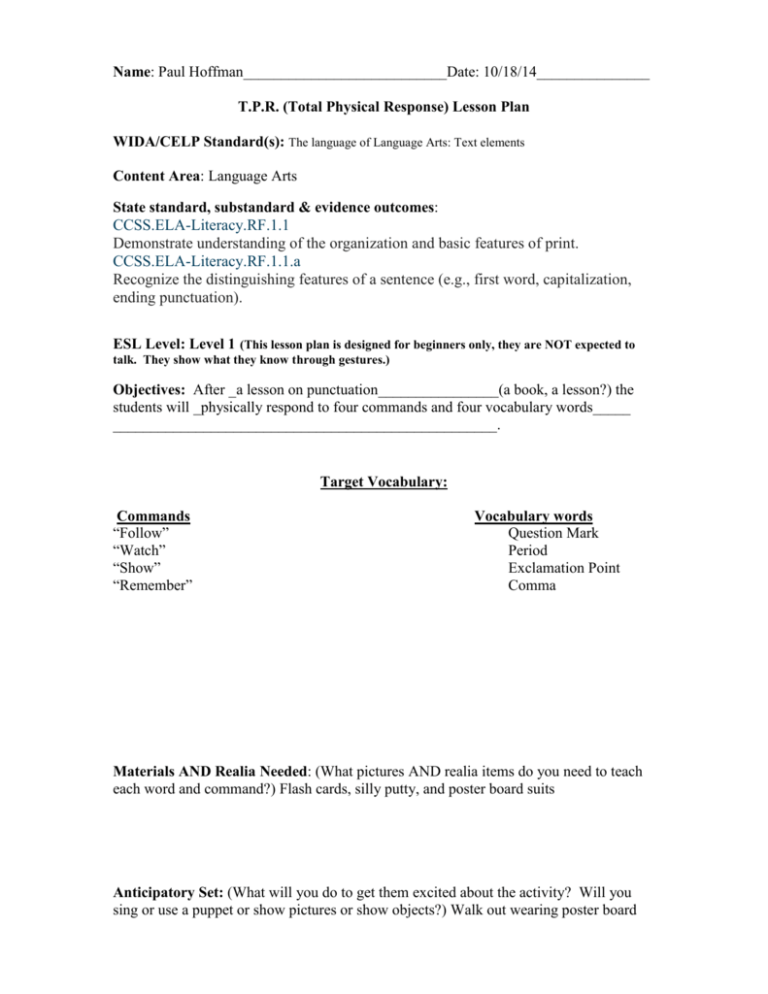
Name: Paul Hoffman___________________________Date: 10/18/14_______________ T.P.R. (Total Physical Response) Lesson Plan WIDA/CELP Standard(s): The language of Language Arts: Text elements Content Area: Language Arts State standard, substandard & evidence outcomes: CCSS.ELA-Literacy.RF.1.1 Demonstrate understanding of the organization and basic features of print. CCSS.ELA-Literacy.RF.1.1.a Recognize the distinguishing features of a sentence (e.g., first word, capitalization, ending punctuation). ESL Level: Level 1 (This lesson plan is designed for beginners only, they are NOT expected to talk. They show what they know through gestures.) Objectives: After _a lesson on punctuation________________(a book, a lesson?) the students will _physically respond to four commands and four vocabulary words_____ ___________________________________________________. Target Vocabulary: Commands “Follow” “Watch” “Show” “Remember” Vocabulary words Question Mark Period Exclamation Point Comma Materials AND Realia Needed: (What pictures AND realia items do you need to teach each word and command?) Flash cards, silly putty, and poster board suits Anticipatory Set: (What will you do to get them excited about the activity? Will you sing or use a puppet or show pictures or show objects?) Walk out wearing poster board with punctuation written on it and dancing to some music. Volunteer students to wear poster boards as well with the other punctuation symbols. Direct Instruction/Modeling/Demonstration: (Look at my example and write down exactly, step-by step what you will say and do to teach them the words and commands.) 1. 2. 3. 4. 5. 6. 7. Include how you will remove support (for scaffolding) as they acquire the vocabulary. The teacher will follow the question mark symbol on the poster board with his/her hand while saying the name of the punctuation mark aloud. S/he will repeat this three times. Using his or her hands, the teacher will then do a large gesture in the air that represents the shape of the symbol. As the teacher gestures, s/he will say the name of the punctuation mark aloud. The teacher will then ask the students to do the gesture with her. (3 times) The teacher will then ask for a volunteer to put on the poster board and create a gesture to represent the next punctuation mark. After the gesture is made, the teacher will ask the volunteer the gesture 3 times as the class mimics the gesture. The teacher is gesturing and saying the name of the punctuation mark aloud as the student’s gesture. (This will be done for exclamation point, period and comma with different volunteers for each). After each punctuation mark has a clear representation of its shape, the teacher will place the question mark flash card under the Doc cam. The teacher will ask the students to remember the gesture that was made for the symbol and show it with their hands three times. The teacher will not gesture with the students at this stage but will still say the name of the mark aloud. (This will be done for each mark). After each flash card has been shown and the gestures have been done for it, the teacher will take the punctuation handout and place it under the Doc cam. After the gestures for the symbols seem to be mastered, the teacher will move on to the individual practice step. Checking for Understanding: (What will you watch for to make sure they understand?) The teacher will watch and make sure each student is making the gestures with their hands. After the teacher stops gesturing with the students, s/he will check to see if the students remember the gestures by using flashcards The teacher will circulate the room checking to see if each student is tracing the symbols with silly putty on the punctuation handout Write down three physical ways students will demonstrate their understanding of commands and vocabulary being practiced: 1. Tracing with fingers and gesturing the symbols with their hands 2. Recalling the gestures created and expressing them using flashcards as a guide 3. Tracing symbols with silly putty. Play a game (or other extension activity): (Describe the game. What are the students doing? What is the teacher doing?) The teacher models how to trace one of the punctuation marks from the handout with silly putty on the Doc cam for the students to see. The teacher hands out the silly putty and the worksheet. The students begin tracing the punctuation marks with the silly putty as the teacher circulates the room and checks for understanding. Evaluation: (How will the teacher know that each child understood the words? What task will they do? What will the teacher watch for? Where will he write it down? What will he do if they get some wrong?) The teacher will know that the students understand the vocabulary words through the expression of the students’ gestures, and the completion of the punctuation handout. At the end of the lesson, the teacher will ask the class to show his/her the gesture for each punctuation mark with no visual cues to assist the students. If they are able to show what the punctuation mark looks like just from the name of it, the teacher will know they understand the name and the way the mark looks. The teacher can grade and write feedback on the punctuation assignment that the students completed and if some of the answers are wrong, the teacher can go back to the first steps and have the student write or draw the symbols or do the gestures again. Closure: (How will you finish the lesson and connect it to the main idea?) The teacher will ask the class to do the gesture for each of the marks without a visual cue and draw the symbols on the board as the student’s gesture. The teacher will explain that each of these symbols are all a part of punctuation and the English Language. Punctuation Practice Question Mark Period Exclamation Point Comma

